
Special Issue: 90 — Informing, Connecting, Inspiring
The Armenian Weekly, October 2024
The Armenian Youth Federation – Youth Organization of the Armenian Revolutionary Federation (AYF-YOARF) is an organization that has impacted and inspired an incalculable number of diasporan Armenians over its proud 91 years of existence.
This impact is often felt at significant large gatherings, whether it be the annual AYF Olympics, local chapter dances, anniversary galas and so on. When generations of AYF members and alumni gather at these events, a special aura seems to float through the air. Although everyone may not know one another personally, they are inherently united through the one common denominator that brought them there: the AYF-YOARF.
Through the pages of the Armenian Weekly and Hairenik Weekly, let’s take a dive through the history of this beautifully crafted organization with a simple but lofty goal: to defeat the powerful foe known as assimilation.
The AYF-YOARF was the brainchild of one of the greatest Armenian patriots in our people’s history: General Karekin Njdeh. Following the Armenian Genocide, with our nation spread across several continents and countries, our dispersed people were at high risk of assimilation. The establishment of churches and community centers was the crucial first step in preserving our religion and Armenian language, culture and heritage. General Njdeh identified the most important successive step: the organization and mobilization of the youth.
As survivors of the Genocide immigrated to the United States, there were many Armenian Revolutionary Federation (ARF) gomidehs established throughout the eastern and western United States. These ARF gomidehs understood that the youth were essential to the preservation of our people and began to set up local youth groups and activities. Structurally, these youth groups operated independently of each other and mainly focused on initiatives within their local frameworks. Some examples of these groups include the Abrilian Sanner, the Gaidzags of Watertown, the Arams of Worcester and the Hyortiks of New York, with the latter three serving as precursors to the eventual AYF-YOARF chapters of the same names. These youth groups preceded the AYF-YOARF organization, some by more than 10 years. Those local ARF gomidehs deserve high praise for having the foresight to mobilize these youth groups ahead of the centralized push that came nearly a decade later.
As the youth groups continued to operate independently, General Njdeh attended the 12th ARF World Congress and proposed the creation of a diasporan Armenian youth organization to promote national awakening and fight assimilation.
On January 14, 1933, the ARF Central Committee of America met in Boston, Massachusetts and officially created a national youth organization, combining the previously mentioned existing youth organizations and setting up new chapters. The responsibility of executing the creation of this new youth organization was given to General Njdeh, and he was sent on a tour of the United States and Canada as a fieldworker. He was accompanied by Kopernik Tandourjian, for whom the current Detroit AYF-YOARF chapter is named.
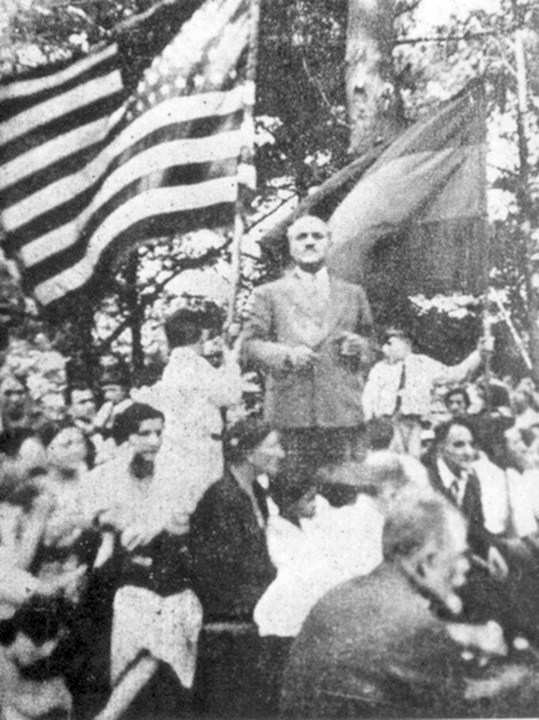 As Njdeh traveled throughout the region, the necessary preparations were made to establish local chapters in each community. A conference in July of 1933 was called to discuss the unification of the existing youth groups into a central organization.
As Njdeh traveled throughout the region, the necessary preparations were made to establish local chapters in each community. A conference in July of 1933 was called to discuss the unification of the existing youth groups into a central organization.
It was decided that the first convention of this newly-founded organization would take place in June of 1934, and new youth organizations would be established over the next year. A variety of activities were held by the newly-formed youth groups, including dances, picnics, song nights, theater and more.
 Between July 1933 and June 1934, a significant decision was made with great impact on the youth. Due to the growing population of predominantly English-speaking youth, the Hairenik Association realized that a crucial demographic would not be reached if the news was not also published in English. This decision commenced the lifelong and ongoing marriage between the AYF-YOARF and the Hairenik Association.
Between July 1933 and June 1934, a significant decision was made with great impact on the youth. Due to the growing population of predominantly English-speaking youth, the Hairenik Association realized that a crucial demographic would not be reached if the news was not also published in English. This decision commenced the lifelong and ongoing marriage between the AYF-YOARF and the Hairenik Association.
Finally, the timeline brings us to the momentous first annual convention in June 1934. The convention took place at the Hairenik Hall in Boston, Massachusetts with over 40 chapters in attendance. The final result of the convention was the official establishment of the ARF Tzeghagron organization. General Njdeh served as an honorary chairman for the first convention, and the core mission of the organization was solidified: the establishment of a free, united and independent Armenia in line with the overarching goal of the ARF.
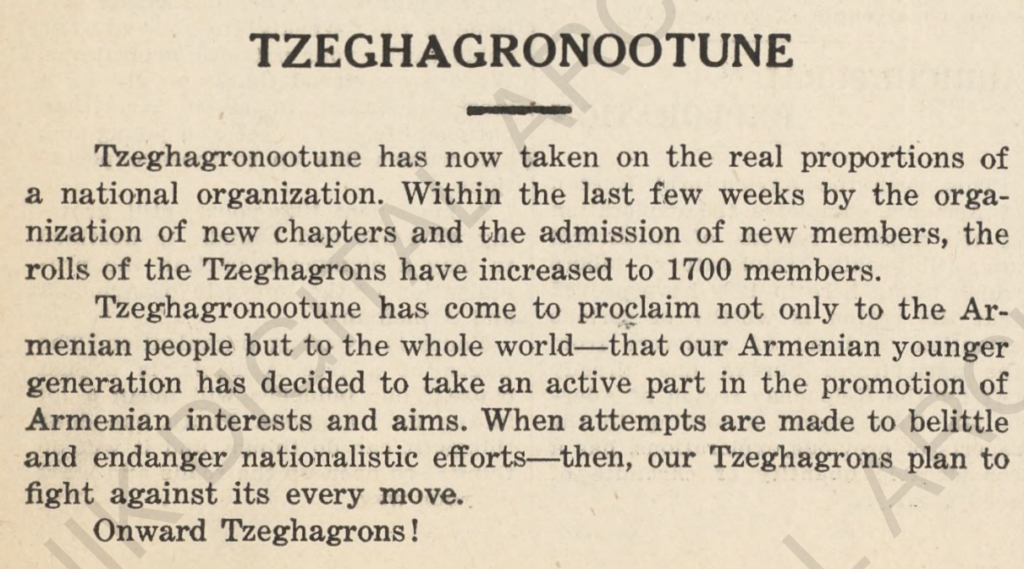 The word Tzeghagron has been translated in many ways, including “young pledgers” and “racial patriots.” Ultimately, the word comes from the Armenian “Ցեղակրօնութիւն” (Tzeghagronoutioun), which was a nationalistic and ethnic ideology and movement idealized by General Njdeh in the 1930s. The concept of Tzeghagronoutioun is just as relevant in 2024 as it was in 1934, as the lack of a nationalistic ideology has found our nation approaching the pits of despair.
The word Tzeghagron has been translated in many ways, including “young pledgers” and “racial patriots.” Ultimately, the word comes from the Armenian “Ցեղակրօնութիւն” (Tzeghagronoutioun), which was a nationalistic and ethnic ideology and movement idealized by General Njdeh in the 1930s. The concept of Tzeghagronoutioun is just as relevant in 2024 as it was in 1934, as the lack of a nationalistic ideology has found our nation approaching the pits of despair.
The first Tzeghagron Sports Festival was held on September 16, 1934. This event marked the beginning of the largest and most popular organizational event, the AYF Olympics. For a full history on the AYF Olympics, please be sure to check out Bob Tutunjian’s article here.
In 1935, the Tzeghagrons’ connection to the Hairenik Weekly became even stronger, as chapters were established, and at a minimum, an entire page in the Weekly was dedicated to highlighting activities and news called “With the Tzeghagrons.”
In the 1940s, the organization adapted to changing landscapes, both domestically and internationally. At the 1941 annual convention in Chicago, the name of the organization was changed from the ARF Tzeghagrons to the Armenian Youth Federation (AYF). The purpose of this change was to broaden the scope of the organization to include all youth, to make the name easier to pronounce and to prevent malicious interpretations of the Tzeghagron name with regards to race.
 As World War II began, the AYF was drastically impacted as a result of the draft. Over 1,000 AYF ungers were drafted into the armed forces, with more than 40 losing their lives. The Armenian Weekly played a crucial role for the AYF in this time period, as the paper served as the means of communication and updates for families and friends of the draftees. Similarly, chapters would communicate with the enlisted. The impact of the Weekly can be seen through this communication, as chapters prepared newsletters to keep the public informed of ongoing activities.
As World War II began, the AYF was drastically impacted as a result of the draft. Over 1,000 AYF ungers were drafted into the armed forces, with more than 40 losing their lives. The Armenian Weekly played a crucial role for the AYF in this time period, as the paper served as the means of communication and updates for families and friends of the draftees. Similarly, chapters would communicate with the enlisted. The impact of the Weekly can be seen through this communication, as chapters prepared newsletters to keep the public informed of ongoing activities.
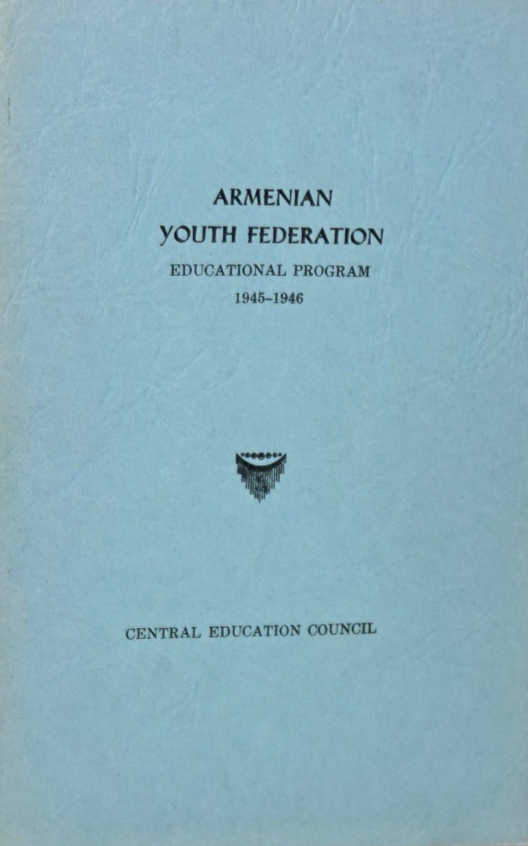 The tail end of the 1940s was a special time for the AYF, as the war ended and members returned home. In 1945-1946, the organization doubled down on its commitment to educating the youth and created the “Blue Book,” largely due to the efforts of Haig Der Manuelian. The “Blue Book” was the beginning of the educational curriculum that the AYF has utilized for decades.
The tail end of the 1940s was a special time for the AYF, as the war ended and members returned home. In 1945-1946, the organization doubled down on its commitment to educating the youth and created the “Blue Book,” largely due to the efforts of Haig Der Manuelian. The “Blue Book” was the beginning of the educational curriculum that the AYF has utilized for decades.
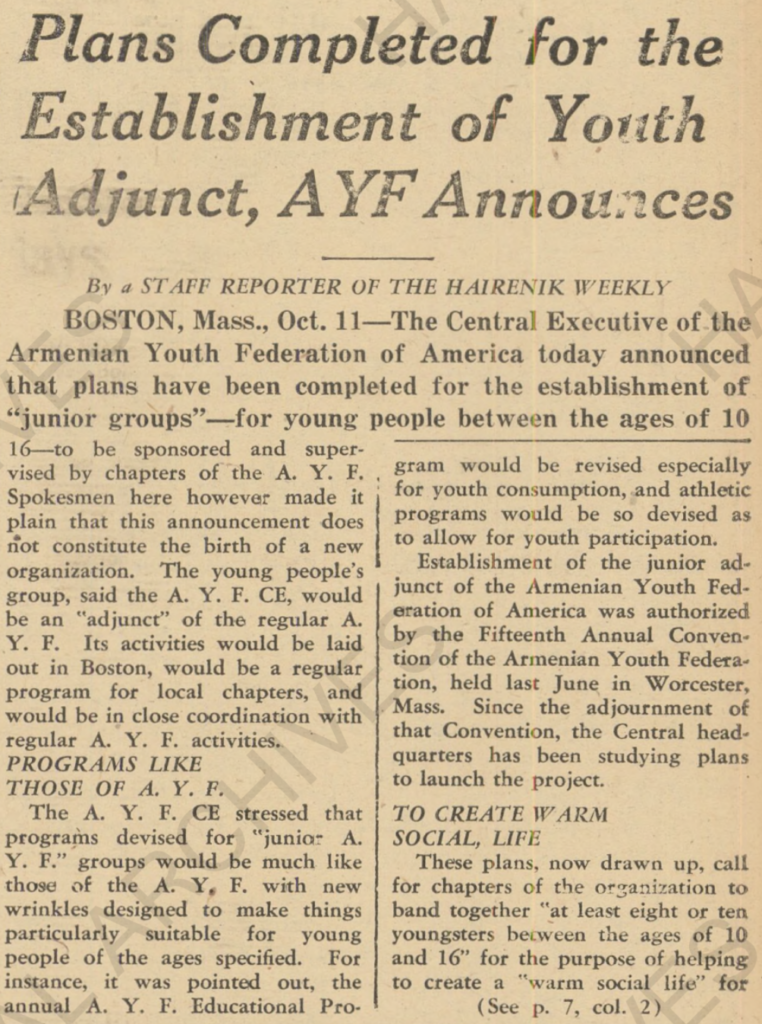 In 1948, an important decision was made at the annual convention to establish an adjunct Junior organization for children ages 10-16, inaugurating the current structure of the AYF. The main leaders of the Junior movement were AYF legends K. Merton Bozoian, Sosy Krikorian Kadian, Mal Varadian and Dick Sarajian. The decade also began with the purchase of AYF Camp Haiastan, and after 10 years of blood, sweat, hard work and dedication, the campgrounds were nearly ready to welcome campers for the first session. Please be sure to check out camp’s article in this magazine.
In 1948, an important decision was made at the annual convention to establish an adjunct Junior organization for children ages 10-16, inaugurating the current structure of the AYF. The main leaders of the Junior movement were AYF legends K. Merton Bozoian, Sosy Krikorian Kadian, Mal Varadian and Dick Sarajian. The decade also began with the purchase of AYF Camp Haiastan, and after 10 years of blood, sweat, hard work and dedication, the campgrounds were nearly ready to welcome campers for the first session. Please be sure to check out camp’s article in this magazine.
 Throughout the 1950s, the AYF continued to grow its membership post-war and honored its Silver Jubilee (25th anniversary) in 1958. In the late 1950s through the 1960s, as the Armenian diaspora gained affluence, started businesses and encouraged children to go to college, the demographics of the U.S. Armenian communities changed. Although the AYF in the early years consisted of over 40 chapters, many were smaller and remote. Families lived in geographically isolated areas, such as Syracuse, Binghamton, Pawtucket, West Pullman and Cleveland, that provided employment opportunities. As families secured their financial stability post-Genocide, they started to move to the suburbs, far from the Armenian ghettos established in many communities. This resulted in the dissolution and consolidation of many smaller chapters.
Throughout the 1950s, the AYF continued to grow its membership post-war and honored its Silver Jubilee (25th anniversary) in 1958. In the late 1950s through the 1960s, as the Armenian diaspora gained affluence, started businesses and encouraged children to go to college, the demographics of the U.S. Armenian communities changed. Although the AYF in the early years consisted of over 40 chapters, many were smaller and remote. Families lived in geographically isolated areas, such as Syracuse, Binghamton, Pawtucket, West Pullman and Cleveland, that provided employment opportunities. As families secured their financial stability post-Genocide, they started to move to the suburbs, far from the Armenian ghettos established in many communities. This resulted in the dissolution and consolidation of many smaller chapters.
One of the single biggest changes to occur in the 1960s was the emergence of political activity in the Armenian community. During this time, there were important changes occurring on the Armenian political scene, such as the 50th anniversary of the Armenian Genocide, which ushered in a new era of demonstrative political action, reiterating demands for reparations and the return of Turkish-occupied Armenian lands.
The 1970s were also a significant decade, with many firsts taking place. These include the first AYF Olympics held in Canada (Montreal, 1970) and California (Los Angeles, 1972) and the first AYF Junior Seminar (1971). The AYF Olympics Governing Body and AYF Camp Haiastan Board of Directors were also established during this time period. Additionally, the 1972 AYF Convention passed the resolution that started the Armenian Youth Foundation.
The most significant change to the structure of the AYF also took place in 1973-1974, as the respective ARF Eastern, Western and Canada regions split into separately functioning regions. The AYF followed this structure to stay consistent with its parent organization, as well as the increasing difficulty of maintaining efficient communication between the rapidly growing regions.
Due to the unstable situations resulting from civil wars in the Middle East, the mid-to-late 1970s saw large waves of immigration to the United States. This brought a different Armenian perspective to the AYF, and the organization had to establish a focus that met the needs of all of its members. As stated in the “The AYF Legacy” book, “Sharp debates over the very nature of the organization ensued… Was it part of a global network, or a peculiarly American-Armenian venture? All of this discussion led to keener thinking, spirited debate, and re-evaluation of the organization’s mission and role.”
During this time, the AYF-YOARF also established the Central Hai Tahd Council, aimed at working closely with the Armenian National Committee of America (ANCA) to coordinate political advocacy and lobbying efforts throughout the region. With the establishment of the ANCA office in Washington, D.C., AYF-YOARF members began to participate in ANCA flagship programs, such as the Leo Sarkisian Internship, Rising Leaders and Summer Academy.
As the 1980s approached, the ARF Bureau created the Bureau Office of Youth Affairs (BOYA) and set out to administratively standardize the AYF regions that had been established throughout the world. This included revisions to by-laws and a new proposed naming convention, resulting in the addition of “-YOARF” to the AYF name. The AYF-YOARF celebrated its Golden Jubilee (50th anniversary), as well as the 50th AYF Olympics, in 1983.
 Born from a desire to maintain inter-regional ties between the Eastern, Western and Canada regions following the split, the first Tri-Regional Seminar was organized in 1984. The seminar was a two-week long event full of historical, educational, political, organizational and leadership discussions. Aside from uniting the regions once again, the main purpose of the seminar was to prepare future leadership within each respective region. It should be noted that the 2024 iteration of the event that took place in June marked 40 years since the inception of the first Tri-Regional Seminar.
Born from a desire to maintain inter-regional ties between the Eastern, Western and Canada regions following the split, the first Tri-Regional Seminar was organized in 1984. The seminar was a two-week long event full of historical, educational, political, organizational and leadership discussions. Aside from uniting the regions once again, the main purpose of the seminar was to prepare future leadership within each respective region. It should be noted that the 2024 iteration of the event that took place in June marked 40 years since the inception of the first Tri-Regional Seminar.
On the athletic front, two staples of the AYF were created with the National Athletic Tournament (NAT) in 1983 and the addition of softball at the AYF Olympics in 1984.
 As the 1980s concluded, the Spitak earthquake and beginning of the Artsakh unification movement in 1988 galvanized the AYF-YOARF membership, and as independence approached in 1991, a new mission of establishing deeper ties with our homeland commenced for the AYF-YOARF membership.
As the 1980s concluded, the Spitak earthquake and beginning of the Artsakh unification movement in 1988 galvanized the AYF-YOARF membership, and as independence approached in 1991, a new mission of establishing deeper ties with our homeland commenced for the AYF-YOARF membership.
 Following Armenia’s independence in 1991, there was a movement to repatriate and return to our homeland labeled Tebi Yergir. Inspired by the movement, the AYF-YOARF quickly mobilized and organized the AYF Internship program in the summer of 1992. Given the significance of this opportunity for its membership, the AYF ensured that articles were written frequently for the Armenian Weekly. The Weekly’s readers needed to hear the voices of the first group of AYF members to see a free Armenia. The AYF Internship celebrated its 30th anniversary in 2022.
Following Armenia’s independence in 1991, there was a movement to repatriate and return to our homeland labeled Tebi Yergir. Inspired by the movement, the AYF-YOARF quickly mobilized and organized the AYF Internship program in the summer of 1992. Given the significance of this opportunity for its membership, the AYF ensured that articles were written frequently for the Armenian Weekly. The Weekly’s readers needed to hear the voices of the first group of AYF members to see a free Armenia. The AYF Internship celebrated its 30th anniversary in 2022.
 There are few greater examples of the Weekly’s influence on the AYF-YOARF than the book published for the 60th anniversary of the organization, known as “The AYF Legacy: Portrait of a Movement in Historical Review.” This publication of history, interviews, pictures and archives serves as a case in point of how the Hairenik and Armenian Weekly inspired the authors of the book to devote countless hours documenting its history and establishing its narrative. There is no doubt that the ability to write and publish “The AYF Legacy” can be credited to the 60 years of articles, recaps, editorials and op-eds that AYF members submitted to the Hairenik and Armenian Weekly.
There are few greater examples of the Weekly’s influence on the AYF-YOARF than the book published for the 60th anniversary of the organization, known as “The AYF Legacy: Portrait of a Movement in Historical Review.” This publication of history, interviews, pictures and archives serves as a case in point of how the Hairenik and Armenian Weekly inspired the authors of the book to devote countless hours documenting its history and establishing its narrative. There is no doubt that the ability to write and publish “The AYF Legacy” can be credited to the 60 years of articles, recaps, editorials and op-eds that AYF members submitted to the Hairenik and Armenian Weekly.
 Following the example of the “Legacy” book, the AYF-YOARF started a publication called Hoki, with the main purpose of displaying the literary and artistic talents of the organization’s membership. Arsineh Khachikian must be recognized and credited as leading the charge behind the publication. Hoki can be viewed as a baby cousin to the Armenian Weekly, which encouraged AYF-YOARF members to continue to develop their creative expression and cultural participation. In total, Hoki published over 20 issues from the late 1990s into the 2000s.
Following the example of the “Legacy” book, the AYF-YOARF started a publication called Hoki, with the main purpose of displaying the literary and artistic talents of the organization’s membership. Arsineh Khachikian must be recognized and credited as leading the charge behind the publication. Hoki can be viewed as a baby cousin to the Armenian Weekly, which encouraged AYF-YOARF members to continue to develop their creative expression and cultural participation. In total, Hoki published over 20 issues from the late 1990s into the 2000s.
Through the 2000s, the AYF-YOARF continued building and improving upon its programs, establishing consistency in the AYF calendar from year to year. In 2008, the AYF celebrated its Diamond Jubilee (75th anniversary). That same year, the AYF-YOARF applied for and received 501c3 nonprofit status.
 In the 2010s, the AYF-YOARF realized its newest programs for furthering the organization’s mission. The first is the ARS Camp Javakhk program, originally called “Tebi Javakhk.” The program was created to establish a connection between the eastern region Armenian youth and the Armenian youth of Javakhk, while also providing educational and financial support to the children there.
In the 2010s, the AYF-YOARF realized its newest programs for furthering the organization’s mission. The first is the ARS Camp Javakhk program, originally called “Tebi Javakhk.” The program was created to establish a connection between the eastern region Armenian youth and the Armenian youth of Javakhk, while also providing educational and financial support to the children there.
In 2014, understanding the importance of financial stability and longevity, the organization established its Arthur Giragosian Endowment Fund. Arthur Giragosian was the chairperson of the first Central Executive and dedicated his life as a fieldworker within the organization. The AYF-YOARF has contributed to the Endowment Fund every year since its establishment, originally with a goal of reaching $1,000,000 by 2037.
The COVID-19 pandemic forced the cancellation of every event in the AYF calendar in 2020, aside from the NAT in Washington, D.C. The Central Executive and its Central Councils were forced to get creative in order to keep the membership engaged through the lockdowns and isolation. The organization, utilizing online meeting platforms, held virtual chapter meetings, organized an online Junior Seminar, and started virtual fundraisers and activities such as “Raffle for the Cause” and “E-Lympics” among others. Once it was determined that the pandemic would not subside prior to Labor Day weekend, the CE also canceled the 2020 AYF Olympics set to take place in Worcester. In its place, the Central Athletic Council (CAC) compiled video interviews and testimonies from previous AYF Olympic athletes, Kings and Queens, in order to keep the Olympic spirit of fraternalism high in a time of isolation. The Armenian Weekly team joined the efforts to offer solace for the disappointment of not having Olympics and produced a special insert dedicated to the spirit of the weekend.
The year 2020 also marked the beginning of the second Artsakh War, resulting in the most significant loss of land and life in Artsakh since the 1994 ceasefire. In 2022 and 2023, the situation in Artsakh only worsened. From the genocidal blockade of food and medical supplies in 2022 to the complete forced deportation of the 120,000+ population of Artsakh, our nation has rarely seen more grave circumstances. During these grueling times, the AYF-YOARF somberly celebrated its 90th anniversary in 2023, marking nine decades since the establishment of the ARF Tzeghagrons by General Njdeh.
As diasporans, the duality of the Armenian diaspora and our homeland is difficult to manage. In the aftermath of genocide, our people recovered and created an unbelievable number of institutions, organizations, schools and more throughout the United States. It is impossible to list all of the diaspora’s successes in preserving our Armenian culture, heritage and language, while continuing to inspire future generations of leaders within our communities. Conversely, the main purpose of these organizations and institutions is to support and work towards our homeland, our Hayastan. Without a secure, prosperous nation with a nationalistic mindset, our road to a free, united and independent Armenia becomes exponentially more challenging.
We must remember the importance of preservation. Our organizations — the AYF-YOARF, ARF, ARS, Homenetmen, Hamazkayin and others — play the important role of maintaining a community to preserve. The Hairenik Weekly, Armenian Weekly, Hairenik and Armenian Review have a crucial role in allowing the communities established by our family of organizations to have a voice and be heard.
While the Armenian nation’s entire existence is under attack by external and internal forces, we must remember to preserve. We cannot allow the 90+ years of the AYF’s history to be forgotten. We cannot allow the stories of our grandparents and great-grandparents who survived the Genocide to be forgotten. We cannot allow cultural erasure to continue, such as the Western Armenian language, the khachkars of Nakhichevan, and most recently, the religious landmarks and institutions being destroyed before our eyes in Artsakh.
Some people may think it is difficult to write. It is becoming a lost art between the advent of social media, and now, artificial intelligence. Many will say, “I never was a writer.” However, it is through contributing to the Weekly that one realizes the greater purpose in writing. It is not only to fill a page in a newspaper, but for yourself as an individual. It is for the community to hear the thoughts of the youth and engage with our activities. It is to canonize our story and allow future generations to look back for inspiration when times are tough. The organs of our organization will continue to allow us to pass down our story for generations to come.
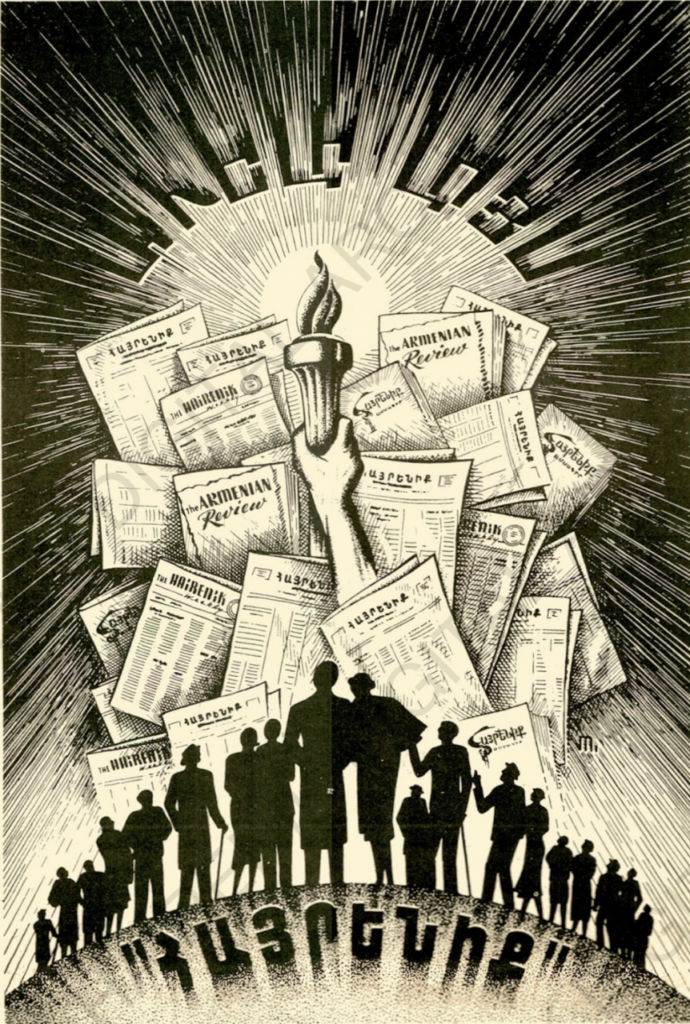 We call on all AYF-YOARF members to pledge to write, with honor — in honor of our history, activities, decades of countless volunteers and our Hai Tahd.
We call on all AYF-YOARF members to pledge to write, with honor — in honor of our history, activities, decades of countless volunteers and our Hai Tahd.
The Armenian Weekly and Hairenik are immortal institutions that will continue to thrive — as long as we, the youth, play our part. Document your story…as part of our story.





















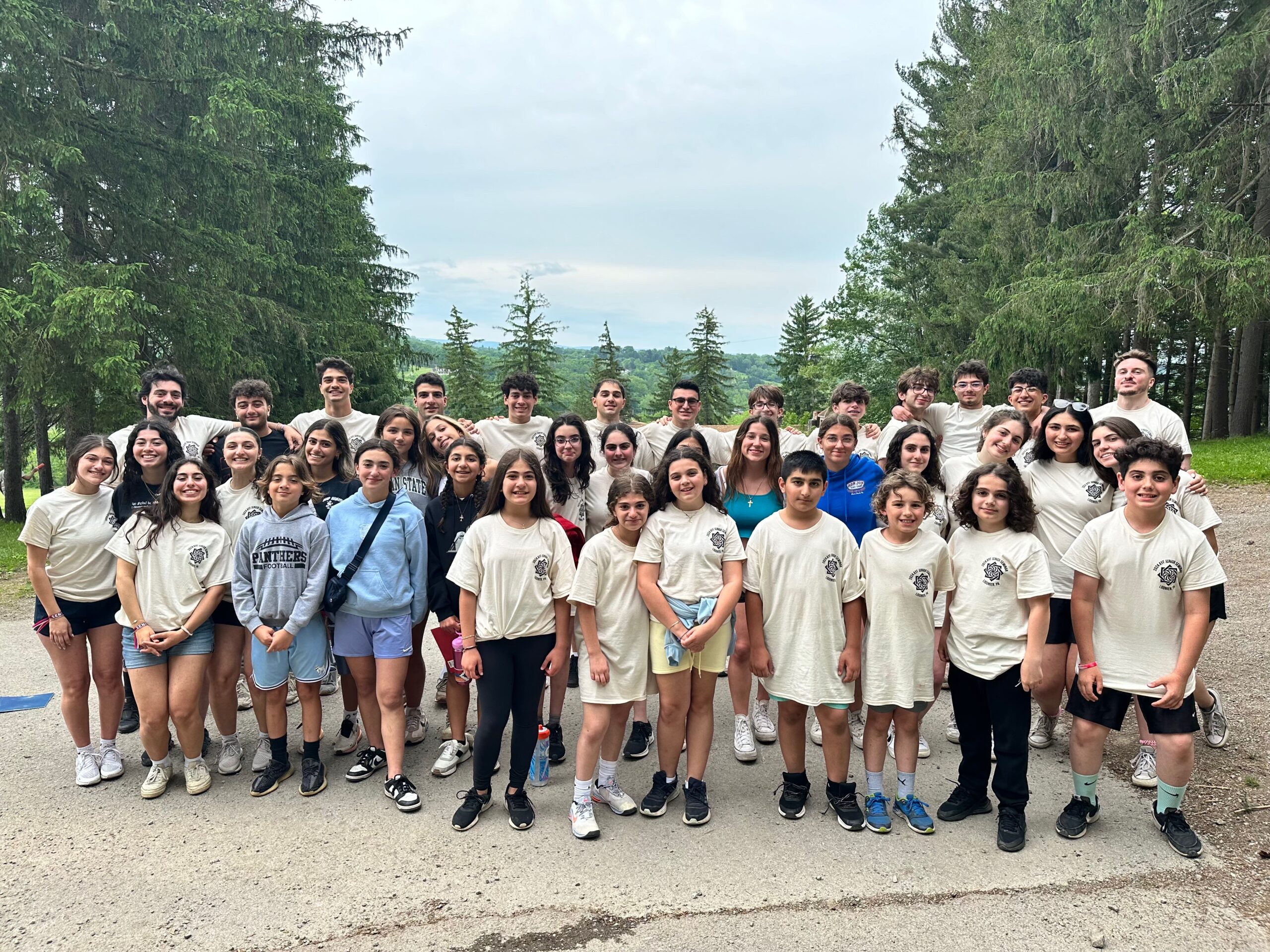


This is a wonderful article, summarizing almost 100 years of Armenian organizations, the AYF and ARF, as well as the value of the writing in the Hairenik and The Armenian Weekly. It is amazing to read about the foresight of our forefathers in America and their successful efforts to preserve and protect Armenian culture for future generations. Thanks for such a meaningful article, complete with photos from the past!!